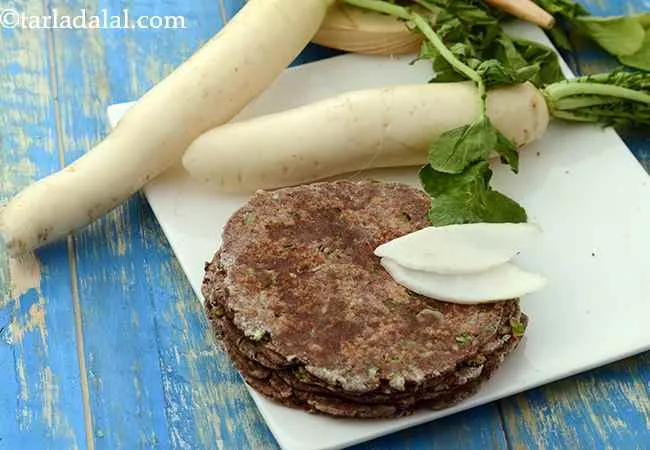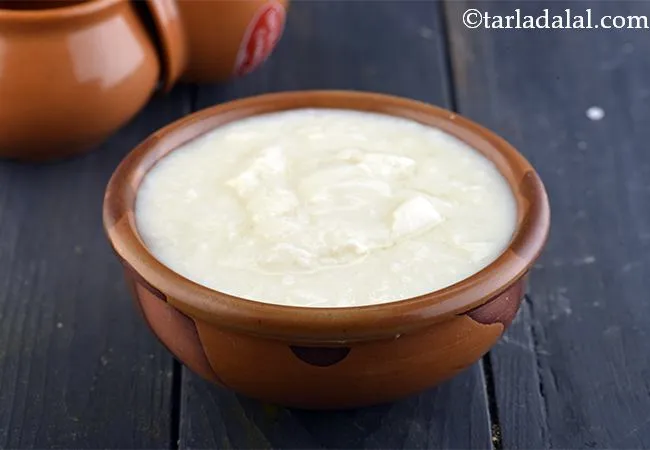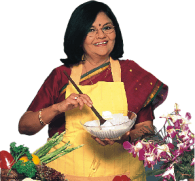Nutritional Facts of mixed vegetable paratha recipe | veg paratha | how to make mix veg paratha | Calories in mixed vegetable paratha recipe | veg paratha | how to make mix veg paratha |
This calorie page has been viewed 26353 times

How many calories does one Vegetable Paratha have?
One Vegetable Paratha gives 153 calories. Out of which carbohydrates comprise 102 calories, proteins account for 16 calories and remaining calories come from fat which is 37 calories. One Vegetable Paratha provides about 8 percent of the total daily calorie requirement of a standard adult diet of 2,000 calories.
Click here to view. Vegetable Paratha recipe. This is quite a favourite dish with all Indians, and you just need to try it once to find out why! The goodness of mixed veggies in the succulent stuffing makes the Vegetable Paratha really satiating, while a dash of everyday spice powders makes it fabulously tasty.
A mix of plain flour and whole wheat flour is used to give the parathas a perfect texture and also to ensure that it is easy to roll. If this mix is not proper, parathas could end up chewy or too tough. The best part about the Mixed Vegetable Paratha is that it is made of everyday ingredients, so you can make it any time you want.
And no need to fret if you do not have any of these veggies in your fridge, just throw in whatever you have, it will be tasty no matter what!
Is Vegetable Paratha healthy?
No, this is not healthy. Let's see why.
Let's understand the Ingredients.
What's good.
1. Whole Wheat flour : Whole wheat flour is excellent for diabetics as they will not shoot up your blood sugar levels as they are a low GI food. Whole wheat flour is rich in Phosphorus which is a major mineral which works closely with calcium to build our bones. Vitamin B9 helps your body to produce and maintain new cells, especially increase red blood cells. See detailed benefits of whole wheat flour and why it's good for you.
2. French Beans ( Fansi ) : French Beans is rich in folic acid. A deficiency of folic acid can also lead to anaemia, as like iron they are equally necessary to make red blood cells. Without enough folic acid, you can get easily tired. Pregnant women can also benefit from its folic acid count. It’s effective to achieve weight loss, overcome constipation, control blood sugar levels, treat high cholesterol as well as prevent cancer. See here for detailed 15 benefits of french beans.
3. Spring Onions : The sulfur compounds in spring onions are known to keep blood pressure under check. Here the sulfur compounds and antioxidant quercetin together help to keep blood sugar levels under control by increasing the production of insulin making it good for Diabetics. Spring onions have also been identified to lower cholesterol levels in the body. The vitamin C also puts you at less risk of heart disease. Being very low in calories and fat and encompassing a basketful of nutrients, they are looked upon as a weight loss vegetable too. See detailed benefits of spring onions.
4. Cauliflower (gobi) : Cauliflower is extremely low in carbs and therefore does not raise blood glucose levels. One cup Cauliflower provides you 100% off your daily recommended allowance of Vitamin C. Rich in Antioxidant. Being rich in Indoles, Cauliflower and other Cruciferous Vegetables like broccoli, kale, radish, brussel sprouts, red cabbage) maintain Estrogen balances which is crucial for women. Read here for detailed benefits of cauliflower.
5.Carrots (gajjar) : Carrots have the nutrient Beta Carotene which is a form of Vitamin A, helps prevent deterioration of the eye as one gets older and prevents night blindness. Carrot is great for the eyes.They relieve constipation, lower blood pressure, have fibre and lower cholesterol. Read the 11 super benefiits of carrots and why to include in your daily diet.
6. Green Chillies : Antioxidant vitamin C in green chillies protects the body from effects of harmful free radicals and prevents stress. It is probably the high fiber which helps in controlling blood sugar levels. This it is a welcome addition to a diabetic diet. Suffering from anaemia? Add green chillies to your list of iron rich foods too. For complete details see benefits of green chilli.
7. Coriander (kothmir, dhania) : Coriander is a fresh herb often used as a flavour enhancer in Indian cooking. It is mainly used as a garnish. This is the best way to use it - no cooking. This preserves its vitamin C content which helps to build our immunity and bring that sparkle to the skin. The antioxidants vitamin A, vitamin C and the quercetin present in coriander works towards strengthening our immune system. Coriander is a fairly good source of iron and folate – the 2 nutrient which help in the production and maintenance of red blood cells in our blood. Good for reducing cholesterol and good for diabetics. Read 9 benefits of coriander to understand details.
What's the problem?
1. Plain flour (maida) : This recipe uses plain flour or maida which is refined carb not suitable for healthy lifestyle. Maida consumption in any food should be totally avoided or just a little bit of usage as any consumption of this will cause a larger spike in blood levels which is not good for diabetics, heart patients. Read is maida good for you to understand fully.
2. Potatoes (Aloo) : Potatoes being high in simple carbohydrates will lead to weight gain and are not good for people with diabetes, heart problem and obesity. Potatoes are recommended for malnourished children and people with low weight. See full details on why potatoes are bad for you.
Can diabetics, heart patients and over weight individuals have vegetable paratha ?
No, this recipe is not good for diabetics, heart and weight loss. This recipe uses plain flour or maida which is refined carb not suitable for healthy lifestyle. Maida consumption in any food should be totally avoided. Potatoes being high in simple carbohydrates will lead to weight gain and are not good for people with diabetes, heart problem and obesity.
Make any of these rotis likes bajra roti, jowar roti, radish nachni roti recipe , basic ragi roti recipe, and whole wheat roti, whole wheat bhakri recipe to make a healthy choice.
Radish Nachni Roti
What is a healthy accompaniment to this paratha?
We suggest you pair it with homemade curds using cows milk or low fat curds or a cucumber and pudina raita.
Low Fat Curds ( How To Make Low Fat Curds)
Can healthy individuals have vegetable paratha ?
No, this recipe is not good for healthy living.
8 Pointers to get healthy on a Indian diet
1. Eat healthy and say yes to good home cooked food. Prefer whole grains like oatmeal, quinoa, buckwheat, barley and healthy flours like bajra flour, jowar flour, quinoa flour, wheat flour etc. rather than refined ones like maida. Have healthy Indian fats like ghee, coconut, coconut oil in your diet.
2. Opt out of junk food, packaged food, deep fried foods. Prefer steamed snacks and other non-fried snacks. Check out some Healthy Indian Snacks. Remember to eat small frequent meals through the day as that will keep you always full and prevent your blood sugar from dropping. By starving your body through some diet, will not help you one bit. In fact, dieting will make you binge on 2 to 3 meals which is not good.
3. Have 4 to 5 servings of vegetables and 2 to 3 servings of fruit is a must. Follow the logic of a vegetable in each main meal of the day and a fruit in-between meals. Check out a few Healthy Indian Soups and Healthy Indian Salads recipes using this food group.
4. Cut down on sugar and salt in your diet and pick honey ( very small amounts) or dates to sweeten your food. Slowly cut the sugar habit as this is not going to happen over night. Sugar is also called white poison. It is a simple carbohydrate with zero nutritional value. On intake, sugar will cause inflammation of the body which will last for many hours. It will spike your blood sugar level and shut down the fat burning process. This also causes high blood sugar levels in your body. The development of prediabetes comes from uncontrolled eating sugar and refined food products for many years and the classic symptom is if you have excess belly fat. This leads to diabetes and further onwards to heart attack, high blood pressure, strokes, impotence and kidney damage.
Salt and blood pressure. Apart from stress and obesity, one of the main reasons for high blood pressure is excessive sodium and salt intake. Most people find it difficult to limit the amount of salt in their cooking, thinking it will affect the taste of their favourite dishes.
This is not true. Bajra and jowar are rich in potassium and critical for those with High Blood Pressure as it lessens the impact of sodium. Eating more Potassium Rich Foods will remove more sodium from your body through urine. So include the basic bajra roti and jowar roti in your daily diet to have with Lower Blood Pressure Subzis Recipes.
5. Befriend a few healthy seeds and nuts like chia seeds, flax seeds, sesame seeds, walnuts and almonds.
6. Sprouts are called ‘living food’. They are high is most nutrients and easy to digest as well. Let them feature in your meals at least thrice a week. Also Read : All Benefits about Sprouts.
7. Exercise 45 minutes every day. No excuse. You can walk fast, run, do weights, play your favourite sport or go to the gym. No activity reduces muscle tissue which will lead to muscke loss and all kinds of problems with that.
8. Sleep early and get up early. Get your body into rhythm and it will function best. Sleep helps your body to recover and makes you look much younger. Also getting good sleep prevent muscle loss.
Vegetable Paratha is high in
1. Vitamin C : Vitamin C is a great defence against coughs and colds.
2. Phosphorous : Phosphorous works closely with calcium to build bones.
Note : a recipe is deemed high in a Vitamin or mineral if it meets 20% and above the recommended daily allowance based on a 2,000 calorie diet.
How to burn 153 calories that come from Vegetable Paratha?
Walking (6 kmph) = 46 mins
Running (11 kmph) = 15 mins
Cycling (30 kmph) = 20 mins
Swimming (2 kmph) = 26 mins
Note: These values are approximate and calorie burning differs in each individual.
| Value per paratha | % Daily Values | |
| Energy | 153 kcal | 8% |
| Protein | 4.1 g | 7% |
| Carbohydrates | 25.6 g | 9% |
| Fiber | 3.36 g | 11% |
| Fat | 4.10 g | 7% |
| Cholesterol | 0.0 mg | 0% |
| VITAMINS | ||
| Vitamin A | 327.0 mcg | 33% |
| Vitamin B1 (Thiamine) | 0.1 mg | 9% |
| Vitamin B2 (Riboflavin) | 0.1 mg | 3% |
| Vitamin B3 (Niacin) | 1.3 mg | 9% |
| Vitamin C | 9.1 mg | 11% |
| Vitamin E | 0.2 mg | 3% |
| Folic Acid (Vitamin B9) | 16.8 mcg | 6% |
| MINERALS | ||
| Calcium | 30.3 mg | 3% |
| Iron | 1.6 mg | 8% |
| Magnesium | 39.4 mg | 9% |
| Phosphorus | 148.0 mg | 15% |
| Sodium | 13.3 mg | 1% |
| Potassium | 130.0 mg | 4% |
| Zinc | 0.6 mg | 4% |
Percent Daily Values are based on a 2000 calorie diet. Your daily values may be higher or lower depending on your calorie needs.

Click here to view Vegetable Paratha, Mixed Vegetable Paratha
Calories in other related recipes



-15088.jpg?w=400&format=webp)

-10065.jpg?w=400&format=webp)











